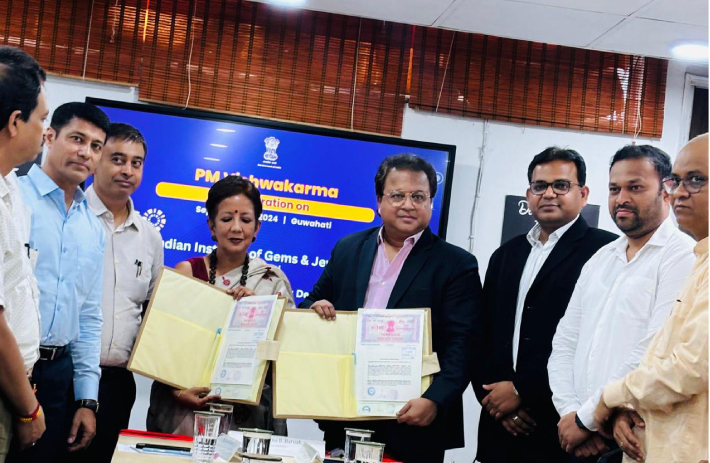
Shri Uday Samant, Hon’ble Minister for Industries, Government of Maharashtra, inaugurated the Indian Institute of Gems & Jewellery (IIGJ), training and skilling centre in Ratnagiri on 24th September in the presence of Shri Kirit Bhansali, Vice Chairman, GJEPC; Shri M. Devender Singh, District Collector, Ratnagiri; Shri Kirthi Kiran Pujar, CEO, Zilla Parishad, Ratnagiri; Shri Sabyasachi Ray, Executive Director, GJEPC; Shri Siddhartha, COO, GJEPC; Shri Debasish Biswas, CEO, IIGJ, amongst others.
The inauguration of the IIGJ Ratnagiri marks a significant step forward in GJEPC’s mission to provide comprehensive education and skill development, ensuring that Maharashtra remains at the forefront of India’s gem and jewellery industry.
Shri Uday Samant, Minister of Industries, Govt. of Maharashtra said, “The gem and jewellery industry is far more than just luxury and aesthetics; it is a crucial economic engine that significantly contributes to a country’s economy. I am grateful to the GJEPC for initiating the training and skilling centre in Ratnagiri. Although it started on a small scale, I am optimistic that it will evolve into a major institute in the coming years. The youth of Ratnagiri and neighboring districts will play a pivotal role in the growth of India’s gem and jewellery industry.”
Kirit Bhansali, Vice Chairman, GJEPC said, “The growth and success of the gem and jewellery sector will heavily depend on skilled manpower. Institutes like IIGJ Ratnagiri and other IIGJs across India will play a crucial role in equipping our youth with the necessary skills to meet this rising demand and drive the industry’s future growth”
“Maharashtra plays a pivotal role in India’s gem and jewellery sector, contributing 70% of India’s total gem and jewellery exports of USD 32 billion in FY 2023-24. With initiatives
like the India-UAE CEPA and other free trade agreements, the industry will see further growth in the coming years.”
“As per the NCAER study, India has a total of 390 gem and jewellery clusters, with Maharashtra leading the way with 29 clusters that employ around 5 lakh people. Efforts are being made to further develop these clusters as export-oriented hubs.”
“Domestically, the rapid expansion of over 3,000 jewellery retail stores across India in the next three years will create a tremendous demand for skilled talent.”
“Additionally, GJEPC is striving to enhance manufacturing through key initiatives such as the India Jewellery Park in Mumbai, and the already established Mega Common Facility Centre (CFC) in Mumbai with well trained and skilled workers and designers”
“With these initiatives, GJEPC aims to generate around 2 lakh jobs in Maharashtra alone, empowering the local workforce and driving sustained growth in the jewellery industry.”
Further speaking on the Council’s commitment to India’s skilling agenda, Kirit Bhansali said, “With the 2024-25 budget setting a target to skill 20 lakh youths over the next five years, GJEPC remains aligned with the Hon’ble Prime Minister’s Shri Narendra Modi’s Skill India mission, by facilitating the industry with training and advanced technology. IIGJ Jaipur and IIGJ Udupi have commenced goldsmith training under the PM Vishwakarma scheme. This will not only help us to ensure sustainable growth of the industry but also achieve the export target of USD 75 billion by 2030.”
“Ratnagiri’s new IIGJ center will contribute significantly towards this goal, training 350 students annually with specialized courses in jewellery design and manufacturing.”
The IIGJ Ratnagiri will offer a variety of courses, including metal setting, CAD (computer- aided design) for jewellery, filling and polishing, and casting machine operation, ensuring that students are equipped with modern, industry-relevant skills.
This new center adds to the network of existing IIGJ facilities operated by GJEPC in Mumbai, Jaipur, and Delhi, all of which are leading the way in jewellery education in India. The Council has also set up satellite training centers in Varanasi and Udupi.
Additionally, Shri Bhansali provided updates on the GJEPC’s initiatives to support traditional jewellery clusters in Maharashtra. Notably, the Hupari Cluster in Kolhapur, which has earned Geographical Indication (GI) status for its renowned silver jewellery, is receiving support from GJEPC. The council is also assisting the local organization in establishing a Common Facility Centre (CFC).
GJEPC and the North Eastern Handicrafts and Handlooms Development Corporation Limited (NEHHDC) signed an MoU on 23rd September to establish the Indian Institute of Gems & Jewellery (IIGJ) in Guwahati. This move marks a significant step towards empowering the gem & jewellery artisans and entrepreneurs in the North East region.




